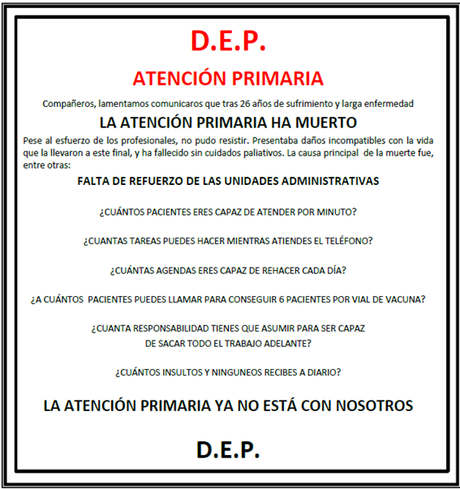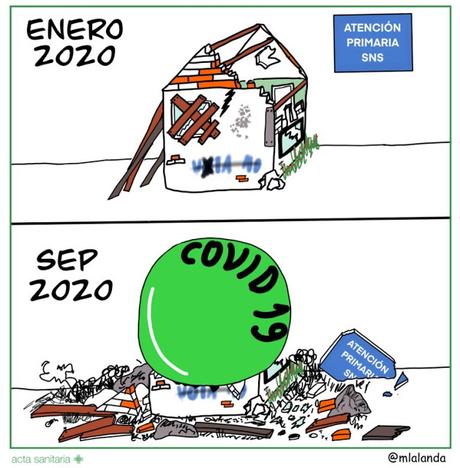
En los últimos meses la narrativa de la Atención Primaria ha virado hacia la parte oscura del arco cromático. Es cierto que nunca habíamos estado tan mal, pero también lo es que estamos atravesando la primera megapandemia que nos ha tocado vivir a esta generación. Esta semana me ha llegado la campaña de un sindicato certificando la muerte de la Atención Primaria. No es la primera vez que se certifica pero sí lo es de la aparición de esquelas funerarias como la que ilustra este artículo. He de reconocer que en algún momento de debilidad he compartido ese diagnóstico pese a que si nos ponemos técnicos no es una tarea sencilla. La muerte de una organización tan grande y compleja implicaría la afectación de un número mayor de centros de salud y de profesionales. Lo que sí parece evidente es que en los dos últimos años han aumentado los centros en llamas, aquejado de una sobrecarga crónica por ausencias de personal no suplidas y repartidas al resto de compañeros durante meses.
Podríamos decir que un equipo de Atención Primaria puede funcionar como un semáforo en condiciones de normalidad (verde), sobrecarga ligera (amarillo) y sobrecarga grave (rojo). El problema es el aumento de los que están en rojo. Nos haría falta un observatorio de Atención Primaria a nivel de cada Comunidad y a nivel nacional. Sin datos no hay paraíso ni forma de gestionar ni plantear mejoras. Las gerencias de AP son las que tienen esta responsabilidad independientemente de que profesionales, sociedades científicas, colegios profesionales o sindicatos pudieran unirse para hacer el suyo.
Si aceptáramos que la Atención Primaria está muerta lo siguiente sería asumir que sus profesionales hemos devenido en zombis, ni profesionalmente vivos ni muertos, es decir trabajando a medio gas. Se acabó la cartera de servicios y el contrato programa tal y como conocíamos por ser incompatible con una agenda que asume pacientes de otros profesionales o que excede un número de visitas muy alto de forma continua.
¿Tiene futuro una organización en la que sus profesionales se sienten zombis o trabajando en un barco que se hunde, o directamente en un cadáver? parece ser que no. Estas narrativas si bien son elocuentes, también son causticas y tóxicas al producir desesperanza, agobio y ansiedad.
Si asumimos que la organización ha muerto quizá tengamos que darnos un golpe de pecho, llorarlo y seguir caminando. El necesario duelo no nos lo quita nadie. Pero hay que seguir. Por eso puede sernos útil considerar la opción a una narrativa de resurrección, que si bien no se vislumbra en el horizonte de la organización (porque es de noche) tal vez podamos ir tanteando a nivel individual y en pequeños grupos por pura supervivencia. Si parece ser cierto que "mientras hay vida hay esperanza" será bueno buscar algo de luz entre tanta tiniebla. Y luces hay. Basta mirar a la medicina de familia rural o a los centros de salud que pese a la tormenta siguen trabajando ofertando una asistencia clínica, familiar y comunitaria dignas. Es fundamental darnos permiso para aceptar que la luz de los que puedan aportar ilumine a los que por sus circunstancias naveguen a oscuras.
¿Hacen falta cambios? ¿hacen falta mejoras? sabemos que sí y también que probablemente tarden. Por eso no podemos hundirnos ni seguir tragando tanta agua. La queja es lo que tiene, uno abre la boca y no puede evitar que las olas la llenen de agua salada. Nos toca elegir, o seguimos bailando el baile loco de los zombis basado en queja y exabruptos o nos pasamos al de los que optan por una nueva narrativa, signifique eso lo que cada cual considere.

Ilustración de la dra. Mónica Lalanda
Zombies or resurrected?
In recent months the Primary Health Care narrative has veered towards the dark side of the chromatic arc. It is true that we have never been so bad, but it is also true that this is the first megapandemic that this generation has had to live through. This week I received a campaign from a trade union certifying the death of Primary Care. It is not the first time that it has been certified, but it is the first time that funeral notices such as the one that illustrates this article have appeared. I must admit that in some moments of weakness I have shared this diagnosis despite the fact that if we get technical it is not a simple task. The death of such a large and complex organization would imply the involvement of a larger number of health centers and professionals. What does seem evident is that in the last two years there has been an increase in the number of centers on fire, suffering from a chronic overload due to staff absences that have not been made up for and have been distributed to the rest of the colleagues for months.
We could say that a primary care team can function as a traffic light with normal conditions (green), light overload (yellow) and severe overload (red). The problem is the increase of those in red. We would need a Primary Care observatory at the level of each Community and at the national level. Without data there is no paradise and no way to manage or propose improvements. The PC managers are the ones who have this responsibility, regardless of whether professionals, scientific societies, professional associations or unions could join forces to do theirs.
If we were to accept that Primary Care is dead, the next step would be to assume that its professionals have become zombies, neither professionally alive nor dead, that is, working at half speed. The portfolio of services and the program contract as we knew them are over because they are incompatible with an agenda that takes on patients from other professionals or that exceeds a very high number of visits on a continuous basis.
Does an organization in which its professionals feel like zombies or working on a sinking ship, or directly on a corpse, have a future? It seems not. While these narratives are eloquent, they are also caustic and toxic, producing hopelessness, overwhelm and anxiety.
If we assume that the organization has died, we may have to beat our chest, mourn it and keep walking. No one can take away the necessary mourning. But we must go on. That is why it may be useful for us to consider the option of a resurrection narrative, which although it is not on the horizon of the organization (because it is night), perhaps we can begin to feel it out at an individual level and in small groups for pure survival. If it seems to be true that "while there is life there is hope" it will be good to look for some light among so much darkness. And there is light. It is enough to look at rural family medicine or local health centers that despite the storm continue to work offering decent clinical, family and community care.
Do we need changes? Do we need improvements? We know that we do and we also know that it will probably take time. That is why we cannot sink or continue to swallow so much water. Complaining is what happens when you open your mouth and you can't stop the waves from filling it with salt water. We have to choose, either we continue dancing the crazy dance of the zombies based on complaints and outbursts or we switch to the dance of those who opt for a new narrative, whatever that means.

Ilustración de la dra. Mónica Lalanda
僵尸还是复活的?
机器翻译,如有错误,敬请原谅。
最近几个月,初级保健的叙述已经偏向于色度弧的黑暗面。我们从未如此糟糕过,这是事实,但这也是我们这一代人经历的第一次大流行病。本周我收到了一个工会的运动,证明初级保健的死亡。这不是第一次认证,但却是第一次出现像本文所说明的葬礼通知。我必须承认,在一些软弱的时刻,我分享了这一诊断,尽管如果我们从技术上讲,这并不是一个简单的任务。这样一个庞大而复杂的组织的死亡,将意味着有更多的卫生中心和专业人员参与。似乎很明显的是,在过去两年中,火烧眉毛的中心数量有所增加,由于工作人员缺勤,长期超负荷工作,几个月来一直被分给其他同事。
我们可以说,一个初级保健团队可以在正常(绿色)、轻度超载(黄色)和严重超载(红色)的条件下发挥交通灯的作用。问题是穿红衣服的人增多。我们需要在每个社区和国家层面上建立一个初级保健观察站。没有数据就没有天堂,也没有办法进行管理或提出改进。AP的管理者是那些有这个责任的人,无论专业人士、科学协会、专业协会或工会可以加入来做他们的工作。
如果我们接受初级保健已经死亡的说法,接下来就会认为其专业人员已经成为僵尸,既没有专业的生命力,也没有死亡,也就是以半速工作。我们所知道的服务组合和方案合同已经结束,因为它们与从其他专业人员那里接收病人或连续超过非常多的访问量的议程不相容。
一个其专业人员感觉像僵尸或在一艘沉船上工作,或直接在一具尸体上工作的组织有前途吗? 似乎没有。虽然这些叙述是雄辩的,但它们也是苛责和有毒的,产生无望、不知所措和焦虑。
如果我们假设该组织已经死亡,我们可能不得不拍拍胸脯,为它哀悼,继续行走。没有人可以夺走必要的哀悼。但我们必须继续下去。这就是为什么我们考虑复活叙事的选择可能是有用的,虽然它不在组织的地平线上(因为它是夜晚),也许我们可以为了生存而开始在个人层面和小团体中感受它。如果 "只要有生命就有希望 "这句话看起来是真的,那么在这么多的黑暗中寻找一些光亮就好了。而且有光。只要看看农村的家庭医学或保健中心,尽管有暴风雨,它们仍然继续工作,提供体面的临床、家庭和社区护理。
我们是否需要改变? 我们是否需要改进? 我们知道我们需要,我们也知道这可能需要时间。这就是为什么我们不能下沉或继续吞下这么多水。抱怨是当你张开嘴,却无法阻止海浪将盐水灌进嘴里时发生的事情。这取决于我们的选择,要么我们继续在抱怨和爆发的基础上跳僵尸的疯狂舞蹈,要么我们转向选择新生活的人的舞蹈,不管这对我们每个人意味着什么。
